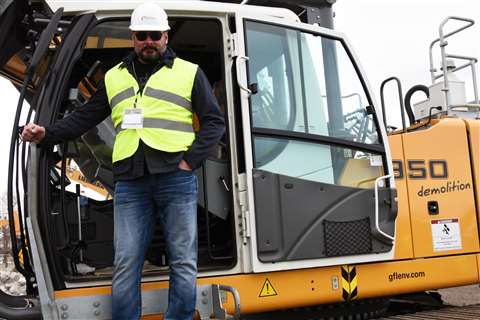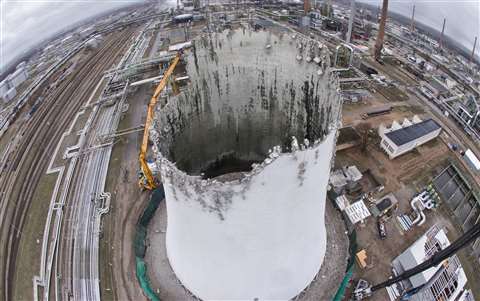Demolition excavators: Onwards and upwards
30 April 2020
GFL Infrastructure Group provides demolition and hazardous materials abatement services through its demolition division, which employs about 150 people.

The company has decades of experience in the industrial and commercial sectors, and a full range of specialised equipment. Based in Toronto, Canada, GFL has several Liebherr high reach demolition machines and “they never let you down,” said Travis Willison, vice president of the company’s demolition division.
“The automatic lube systems on them are fantastic. The hydraulic systems are amazing. One of the major benefits of the machine is it’s a single float, so anytime you need to pick it up to go somewhere it’s quite easy.”
Dozens of people had an opportunity to operate the R 950 and four other Liebherr machines at the US National Demolition Association’s Live Demo event at Demolition Rockies 2019 in Aurora, Colorado.
The manufacturer said that R 950 demolition excavators are fast, efficient, safe and purpose built for selective deconstruction of large industrial buildings, and as the entire machine is made by Liebherr, all systems are complementary and integrated into the design. By working from the ground, a Liebherr high reach can eliminate the need of having another piece of equipment on site to take down structures below 4.6 m (15 ft). The machine can work in a 360° radius, which important on tight sites and makes installing demolition attachments easier.
“The industry in Toronto has changed a lot,” said Travis.
“Everything is getting tighter. There is no space, no room to get at things. To be able to put a machine in that can hit, quite easily, 21 to 24 m (70 or 80 ft) and do work safely and efficiently in a tight spot is a bonus.”
Major jobs for the R950
With a reach of 25 m (83 ft) and the capacity to handle a 3,500 kg (7,720 lb) tool, the R 950 is large enough for major jobs. But despite its size, the R 950 is easily transportable thanks to a hydraulically expandable undercarriage. Liebherr said the undercarriage makes the machine easier to move to and from sites because it retracts the undercarriage width. It also can expand to create a wider footprint, which enhances stability.
The company also works with clients to implement job-specific, environmentally sustainable waste management, disposal and erosion control methods.
“We’re really busy,” Travis said.
“Adding the Liebherr R 950 to the fleet will help us build and grow our company to the next level. We’ve got the right equipment for the work.”
Liebherr high reach excavators also have a plug in boom section where the attachment is mounted, allowing the machine to be used for multiple tasks. A camera provides visibility to the operator when tools are placed inside structures and gives the operator a better view when the end of the tool is out of sight.
“High reach machines have eliminated the wrecking ball,” said Travis, who has nearly 20 years of experience in the industry.
“Modern demolition machines are much safer, much neater, much quicker. You can organise your material properly.
“The operator is a safe distance away from the building when he’s working. It’s the way of the future.”

Mrózek in the Czech Republic is a demolition company with experience dating back 30 years.
In 2008 the company purchased a Liebherr R 974 B VH-HD Litronic demolition excavator. In 2013, however, the owner of the company, Bohuslav Mrózek, decided to rebuild this excavator so it could have the highest possible amount of reach.
Rebuilt for reach – the R974
In the same year, the excavator was rebuilt from the original 41 m (134 ft) to the highest possible reach of 55 m (180 ft), and its weight was increased from 120 t to 183 t.
After the rebuild, the excavator has up to 10 possible configurations for demolition work and is able to work with crushers weighing up to 2 t over a range of 55 m.
At 52 m (170 ft), this becomes 2.5 t; at 46 m (150 ft) it works with crushers weighing 5 t. Other weights are 6 t at 30 m (98 ft), 8 t at 28 m (92 ft); and 14 t at 24 m (78 ft).
It can also work with hydraulic tools weighing 20 to 24 t and at a depth of 16 m (52 ft) as an 80 t excavator.
This excavator is mainly used for demolition of tall buildings, chimneys, halls and bridges.
In 2019, it was also used to demolish the cooling tower in Schwedt, Germany.
The tower measured 55 m, its diameter was 25 m (82 ft) and there were other pipelines only 8 m (26 ft) away.
The works were completed to the satisfaction of the customer within two months.
In an earlier example, the demolition of heating plant T200 for Unipetrol PRA, Litvínov was one of the biggest projects where the reconstructed Liebherr R 974 high reach had been used.
It was one of the largest demolitions in the Czech Republic in recent years, covering three reinforced concrete chimneys of around 100 m (328 ft) in height, 12 electric separators, boiler and engine room, pumping station, consumption room and ash delivery.
Three chimneys were lowered to 50 m (164 ft) with the help of remote-controlled robots and demolished with a help of a Liebherr R 974 demolition excavator.
All structures were demolished according to the project.
Over 33 000 t of the scrap was mined, and 80% of the work was done in six months.
- Article first published in the January-February 2020 issue of Demolition & Recycling International






